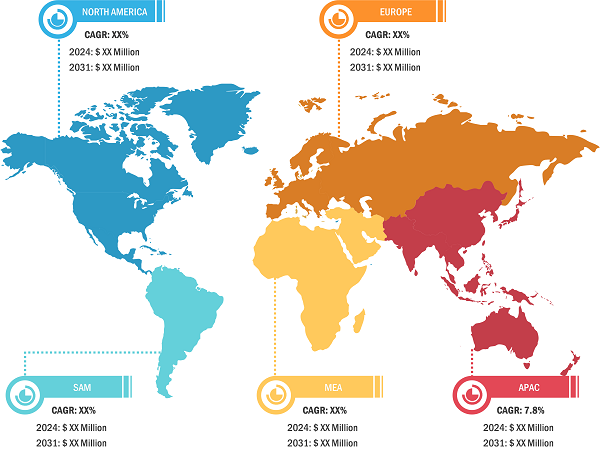Digitalization and Automation in Oilfields Fuel Wireless Antenna Market Growth
According to our latest study, "Wireless Antenna Market Size and Forecast (2021–2031), Global and Regional Share, Trend, and Growth Opportunity Analysis – by hardware, software, sales, application, and technology, and Geography," the market was valued at US$ 4.64 billion in 2024 and is expected to reach US$ 7.04 billion by 2031; it is estimated to register a CAGR of 6.2% during 2025–2031. The report includes growth prospects owing to the current Wireless Antenna market trends and their foreseeable impact during the forecast period.
The wireless antenna market growth is driven by the adoption of 5G technology, which encompasses a greater spectrum, including millimeter wave (mmWave) frequencies ranging from 24 GHz to 100 GHz. These high frequencies provide fast data transfer rates, low latency, and support for a large number of connected devices. These capabilities are essential for developing self-driving cars, smart cities, the Internet of Things (IoT), augmented reality (AR), and advanced telemedicine applications. These functionalities allow 5G to work with a dense network of small cell base stations to achieve the performance of the above-developing technologies. The small cell base stations rely on a diverse range of wireless antennas that work with millimeter-wave (mmWave), sub-6 GHz, and massive MIMO (multiple-input, multiple-output) frequencies. This frequency spectrum facilitates faster data throughput with a shorter range and lower penetration capacity. This limitation requires the installation of a larger amount of small antennas in street furniture, buildings, and automobiles. Thus, the rising adoption of 5G communication technology and the development of 5G infrastructure worldwide increases the demand for advanced and high-frequency wireless antennas, boosting the wireless antenna market growth.
Wireless Antenna Market Analysis — by Geography

Wireless Antenna Market Size & Share Analysis Report 2031
Download Free SampleWireless Antenna Market Size and Forecast (2021 - 2031), Global and Regional Share, Trend, and Growth Opportunity Analysis Report Coverage: By Product Type (Omni-Directional Antenna, Semi-Directional Antenna, and Highly-Directional Antenna), Omni-directional Antenna (Monopole Antenna, Dipole Antenna, Helical Antenna, and Others), Semi-directional Antenna (Patch, Panel, Sector, and Others), Highly-directional Antenna (Parabolic Dish, Grid Antenna, Yagi-Uda Antenna, and Others), Technology (5G, 4G or LTE, Wi-Fi, Bluetooth, GPS or GNSS, and Others), Industry (Telecommunications, Consumer Electronics, Mining, Aerospace and Defense, Industrial, Automotive and Transportation, and Others), and Geography
Source: The Insight Partners Analysis
Panorama Antennas Ltd.; Sinclair Technologies Inc; Airgain, Inc.; Cisco Systems Inc; Ezurio; Huawei Technologies Co Ltd; PCTEL Inc.; 2J Antennas S.R.O.; Parsec Technologies; Quectel Wireless Solutions Co Ltd; Johanson Technology Incorporated; TE Connectivity Ltd; Pulse Electronics; Taoglas; Hubbell Inc; Mobile Mark, Inc; and Galtronics USA, Inc. are among the key players profiled in the wireless antenna market report. Other major players were also studied and analyzed in the market study to get a holistic view of the market and its ecosystem.
The report includes the wireless antenna market forecast by product type, application, technology, and industry. Based on product type, the market is segmented into omnidirectional antenna, semi-directional antenna, and highly directional antenna. The omni-directional antenna is divided into monopole antenna, dipole antenna, helical antenna, and others. Semi-directional antenna is segmented into patch, yagi, panel, and others. The highly directional antenna is categorized into the parabolic dish, grid antenna, and others. Per technology, the market is segmented into 4G/LTE, Wi-Fi, Bluetooth, GPS/GNSS, 5G technology, and others. The 5G segment held the largest wireless antenna market share in 2024. By industry, the market is divided into telecommunications, consumer electronics, aerospace and defense, industrial, automotive and transportation, mining, and others. The telecommunications segment held the largest wireless antenna market share in 2024.
The scope of the Wireless Antenna market report focuses on North America (the US, Canada, and Mexico), Europe (Spain, the UK, Germany, France, Italy, and the Rest of Europe), Asia Pacific (China, India, Japan, Australia, Indonesia, and the Rest of Asia Pacific), the Middle East & Africa (South Africa, Saudi Arabia, the UAE, and the Rest of Middle East & Africa), and South & Central America (Brazil, Argentina, and the Rest of South & Central America).
Geographically, the Wireless Antenna Market is segmented into North America, Europe, Asia Pacific, Middle East and Africa, and South and Central America. Asia Pacific dominated the Wireless Antenna Market. North America is the second-largest contributor to the global Wireless Antenna Market, followed by Europe.
The Europe wireless antenna market is divided into Germany, France, Italy, the US, Russia, and the Rest of Europe. Europe’s advancements in Industry 4.0 and smart manufacturing drive the demand for wireless antennas to support real-time data communication. In June 2022, the Wireless Broadband Alliance (WBA), the global trade body for Wi-Fi technology development, released guidelines outlining critical features to advance Wi-Fi 6/6E standards, specifically addressing applications in the Internet of Things (IoT) and Industry 4.0.
The Asia Pacific wireless antenna market is segmented into Australia, India, China, Japan, South Korea, and the Rest of Asia Pacific. China, Japan, South Korea, and India are undergoing expansion, underpinned by proactive government policies, significant capital investment in telecom infrastructure, and a growing mobile user base. The surging adoption of IoT devices, smart city initiatives, and industrial automation across the region is accelerating the need for high-performance wireless antenna solutions. The number of IoT devices in use across India, Bangladesh, Indonesia, and Thailand is projected to surge from 14.5 billion in 2022 to an estimated 38.9 billion by 2030. The Asia Pacific region hosts several of the world's top manufacturers in the global consumer electronics sector. In 2023, mobile technologies and services generated a total economic contribution of US$ 880 billion. Thus, such a rise in IoT device adoption and mobile technologies drives the wireless antenna market growth in the region.
Contact Us
Phone: +1-646-491-9876
Email Id: sales@theinsightpartners.com